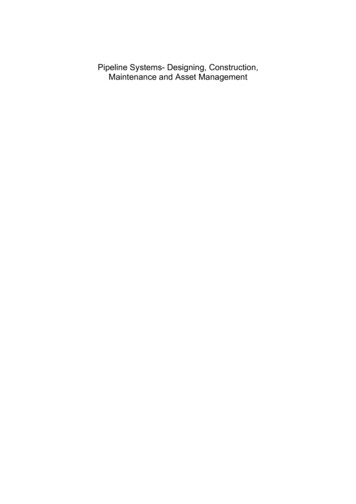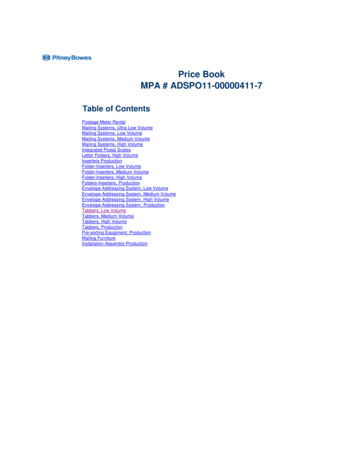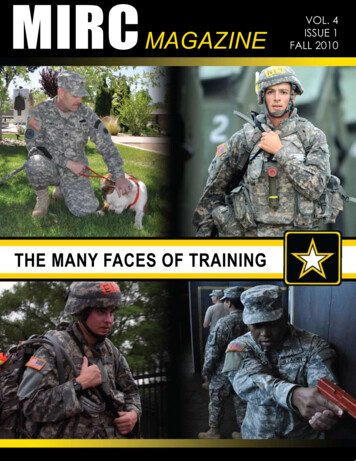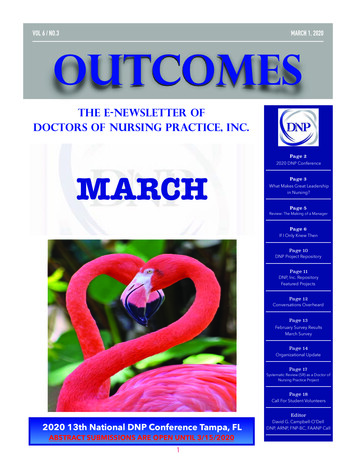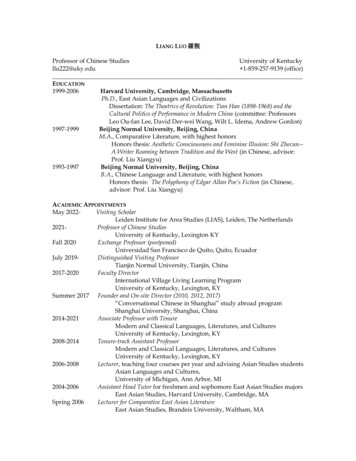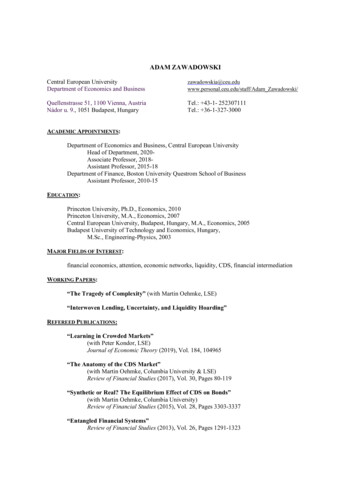
Transcription
This is a preview of "M41-A". Click here to purchase the full version from the ANSI store.M41-AVol. 26 No. 35Replaces M41-PVol. 26 No. 7Viral Culture; Approved GuidelineThis document provides guidance for viral culture and identification proceduresperformed in the clinical virology laboratory.A guideline for global application developed through the Clinical and LaboratoryStandards Institute consensus process.
This is a preview of "M41-A". Click here to purchase the full version from the ANSI store.Clinical and Laboratory Standards InstituteAdvancing Quality in Healthcare TestingClinical and Laboratory Standards Institute (CLSI,formerly NCCLS) is an international, interdisciplinary,nonprofit, standards-developing, and educationalorganization that promotes the development and use ofvoluntary consensus standards and guidelines within thehealthcare community. It is recognized worldwide for theapplication of its unique consensus process in thedevelopment of standards and guidelines for patienttesting and related healthcare issues. Our process isbased on the principle that consensus is an effective andcost-effective way to improve patient testing andhealthcare services.In addition to developing and promoting the use ofvoluntary consensus standards and guidelines, weprovide an open and unbiased forum to address criticalissues affecting the quality of patient testing and healthcare.PUBLICATIONSA document is published as a standard, guideline, orcommittee report.Standard A document developed through the consensusprocess that clearly identifies specific, essentialrequirements for materials, methods, or practices for usein an unmodified form. A standard may, in addition,contain discretionary elements, which are clearlyidentified.GuidelineA document developed through theconsensus process describing criteria for a generaloperating practice, procedure, or material for voluntaryuse. A guideline may be used as written or modified bythe user to fit specific needs.Most documents are subject to two levels of consensus—“proposed” and “approved.” Depending on the need forfield evaluation or data collection, documents may also bemade available for review at an intermediate consensuslevel.Proposed A consensus document undergoes the first stageof review by the healthcare community as a proposedstandard or guideline. The document should receive a wideand thorough technical review, including an overall reviewof its scope, approach, and utility, and a line-by-line reviewof its technical and editorial content.Approved An approved standard or guideline has achievedconsensus within the healthcare community. It should bereviewed to assess the utility of the final document, toensure attainment of consensus (i.e., that comments onearlier versions have been satisfactorily addressed), and toidentify the need for additional consensus documents.Our standards and guidelines represent a consensus opinionon good practices and reflect the substantial agreement bymaterially affected, competent, and interested partiesobtained by following CLSI’s established consensusprocedures. Provisions in CLSI standards and guidelinesmay be more or less stringent than applicable regulations.Consequently, conformance to this voluntary consensusdocument does not relieve the user of responsibility forcompliance with applicable regulations.COMMENTSThe CLSI voluntary consensus process is a protocolestablishing formal criteria for:The comments of users are essential to the consensusprocess. Anyone may submit a comment, and all commentsare addressed, according to the consensus process, by thecommittee that wrote the document. All comments,including those that result in a change to the document whenpublished at the next consensus level and those that do notresult in a change, are responded to by the committee in anappendix to the document. Readers are strongly encouragedto comment in any form and at any time on any document.Address comments to Clinical and Laboratory StandardsInstitute, 940 West Valley Road, Suite 1400, Wayne, PA19087, USA. the authorization of a projectVOLUNTEER PARTICIPATION the development and open review of documents the revision of documents in response to commentsby users Healthcare professionals in all specialties are urged tovolunteer for participation in CLSI projects. Please contactus at customerservice@clsi.org or 610.688.0100 foradditional information on committee participation.the acceptance of a document as a consensusstandard or guideline.Report A document that has not been subjected toconsensus review and is released by the Board ofDirectors.CONSENSUS PROCESS
This is a preview of "M41-A". Click here to purchase the full version from the ANSI store.Volume 26 Number 35M41-AISBN 1-56238-623-9ISSN 0273-3099Viral Culture; Approved GuidelineLorraine M. Clarke, PhDHolly Alexander, PhDMary Beth Baker, MS, SV (ASCP), RM (AAM)Matthew J. Bankowski, PhD, D (ABMM)Carol KirkMichael J. Loeffelholz, PhD, D (ABMM)James B. Mahony, PhDD. Kathleen WrightMartin R. Evans, PhDPatricia C. Harris, MS, SM (AAM)Robyn L. McGuire, PhDElla M. Swierkosz, PhDAbstractThis document provides guidance for viral culture and identification procedures that are typically performed in the clinicalvirology laboratory setting using commercially available cell cultures and reagents. The nature of the cell culture system is onethat is inherently variable and thus remains susceptible to numerous adverse conditions that can lead to unreliable results.Several critical elements that must be addressed in devising a viral culture procedure are identified. These include: cell cultureselection, assessment and maintenance; cell culture verification and quality control; culture medium preparation and qualitycontrol; specimen collection and preparation; isolate identification; and result reporting and interpretation. The intended audienceincludes laboratories performing either limited or comprehensive viral cultures as well as those that are considering introductionof viral culture. Regardless of the viral diagnostic testing algorithm utilized by a laboratory, the basic principles of viral cultureare universal.Clinical and Laboratory Standards Institute (CLSI). Viral Culture; Approved Guideline. CLSI document M41-A (ISBN 1-56238623-9). Clinical and Laboratory Standards Institute, 940 West Valley Road, Suite 1400, Wayne, Pennsylvania 19087-1898 USA,2006.The Clinical and Laboratory Standards Institute consensus process, which is the mechanism for moving a document throughtwo or more levels of review by the healthcare community, is an ongoing process. Users should expect revised editions of anygiven document. Because rapid changes in technology may affect the procedures, methods, and protocols in a standard orguideline, users should replace outdated editions with the current editions of CLSI/NCCLS documents. Current editions arelisted in the CLSI catalog, which is distributed to member organizations, and to nonmembers on request. If your organization isnot a member and would like to become one, and to request a copy of the catalog, contact us at: Telephone: 610.688.0100; Fax:610.688.0700; E-Mail: customerservice@clsi.org; Website: www.clsi.org(Formerly NCCLS)
This is a preview of "M41-A". Click here to purchase the full version from the ANSI store.Number 35M41-ACopyright 2006 Clinical and Laboratory Standards Institute. Except as stated below, neither thispublication nor any portion thereof may be adapted, copied or otherwise reproduced, by any means(electronic, mechanical, photocopying, recording, or otherwise) without prior written permission fromClinical and Laboratory Standards Institute (“CLSI”).CLSI hereby grants permission to each individual member or purchaser to make a single reproduction ofthis publication for use in its laboratory procedure manual at a single site. To request permission to usethis publication in any other manner, contact the Executive Vice President, Clinical and LaboratoryStandards Institute, 940 West Valley Road, Suite 1400, Wayne, Pennsylvania 19087-1898, USA.Suggested Citation(Clinical and Laboratory Standards Institute. Viral Culture; Approved Guideline. CLSI document M41-A[ISBN 1-56238-623-9]. Clinical and Laboratory Standards Institute, 940 West Valley Road, Suite 1400,Wayne, Pennsylvania 19087-1898 USA, 2006.)Proposed GuidelineJanuary 2006Second PrintingFebruary 2006Approved GuidelineNovember 2006ISBN 1-56238-623-9ISSN 0273-3099ii
This is a preview of "M41-A". Click here to purchase the full version from the ANSI store.Volume 26M41-ACommittee MembershipArea Committee on MicrobiologyMary Jane Ferraro, PhD, MPHChairholderMassachusetts General HospitalBoston, MassachusettsJames H. Jorgensen, PhDVice-ChairholderUniversity of Texas HealthScience CenterSan Antonio, TexasDonald R. Callihan, PhDBD Diagnostic SystemsSparks, MarylandThomas R. Shryock, PhDElanco Animal HealthGreenfield, IndianaJana M. Swenson, MMScCenters for Disease Control andPreventionAtlanta, GeorgiaMichael L. Wilson, MDDenver Health Medical CenterDenver, ColoradoRichard L. Hodinka, PhDChildren’s Hospital ofPhiladelphiaPhiladelphia, PennsylvaniaMichael A. Pfaller, MDUniversity of Iowa College ofMedicineIowa City, IowaRobert P. Rennie, PhDUniversity of Alberta HospitalsEdmonton, CanadaAdvisorsFreddie Mae PooleFDA Center for Devices andRadiological HealthRockville, MarylandEllen Jo Baron, PhDStanford University Hospital &Medical SchoolStanford, CaliforniaDavid L. Sewell, PhDVeterans Affairs Medical CenterPortland, OregonLynne S. Garcia, MSLSG and AssociatesSanta Monica, CaliforniaMelvin P. Weinstein, MDRobert Wood Johnson MedicalSchoolNew Brunswick, New JerseyGail L. Woods, MDUniversity of Arkansas forMedical SciencesLittle Rock, ArkansasSubcommittee on Viral CultureLorraine M. Clarke, PhDChairholderNew York State Dept. of HealthAlbany, New YorkD. Kathleen WrightFDA Ctr. for Devices/Rad. HealthRockville, MarylandSteven Specter, PhDUniversity of South Florida Collegeof MedicineTampa, FloridaAdvisorsHolly Alexander, PhDVia Christi Regional MedicalCenterWichita, KansasMartin R. Evans, PhDVerlander, Evans and AssociatesOyster Bay, New YorkMary Beth Baker, MS, SV(ASCP),RM(AAM)Spokane, WashingtonPatricia C. Harris, MS, SM(AAM)Diagnostic Hybrids, Inc.Henderson, NevadaMatthew J. Bankowski, PhD,D(ABMM)Diagnostic Laboratory Services,Inc.Honolulu, HawaiiRichard L. Hodinka, PhDChildren’s Hospital of PhiladelphiaPhiladelphia, PennsylvaniaCarol KirkWisconsin State Laboratory ofHygieneMadison, WisconsinMichael J. Loeffelholz, PhD,D(ABMM)ViroMed LaboratoriesMinnetonka, MinnesotaJames B. Mahony, PhDSt. Joseph’s HospitalHamilton, Ontario, CanadaRobyn L. McGuire, PhDSouthern California Region BloodServicesLos Angeles, CaliforniaMarilyn A. Menegus, PhDUniversity of Rochester MedicalCenterRochester, New YorkLinda L. Minnich, MS, SMCharleston Area Medical CenterCharleston, West VirginiaElla M. Swierkosz, PhDSt. Louis University School ofMedicineSt. Louis, MissouriKenneth D. Thompson, PhDThe University of Chicago MedicalCenterChicago, IllinoisWashington C. Winn, Jr., MDFletcher Allen Health CareBurlington, VermontStaffClinical and Laboratory StandardsInstituteWayne, PennsylvaniaJohn J. Zlockie, MBAVice President, StandardsTracy A. Dooley, BS, MLT (ASCP)Staff LiaisonDonna M. WilhelmEditorMelissa A. LewisAssistant Editoriii
This is a preview of "M41-A". Click here to purchase the full version from the ANSI store.Number 35M41-AAcknowledgementCLSI acknowledges the expert and his institution listed below for the “special review,” advice,and help in preparing the approved-level edition of this guideline:Dean D. Erdman, Dr. P.H., Centers for Disease Control and Preventioniv
This is a preview of "M41-A". Click here to purchase the full version from the ANSI store.Volume 26M41-AContentsAbstract .iCommittee Membership. iiiForeword . vii1Scope.12Introduction.13Standard Precautions.14Definitions .25Monolayered Cell Cultures and Cell Culture Medium (Preanalytical).35.15.25.35.46Specimens for Viral Culture (Preanalytical).136.16.26.36.46.56.67Design of Viral Culture Algorithms .26Inoculation Procedure .29Incubation and Maintenance of Inoculated Cell Cultures.31Examination of Inoculated Cell Culture Monolayers .33Storage of Viral Isolates .40Quality Assessment.408.18.29General Principles.13Specimen Collection .13Transport and Storage .19Assessment Criteria .20Processing .21Storage of Processed and Residual Specimens .25Viral Culture Using Monolayered Cell Cultures (Analytical) .257.17.27.37.47.58Cell Culture Variables Affecting Susceptibility to Viral Infection.3Types of Culture Vessels .5Assessment, Maintenance, and Quality Control of Uninoculated Monolayered CellCultures.6Cell Culture Medium .9Summary of QI/QC Practices in This Document.41Troubleshooting .41Postanalytical Considerations .429.19.29.3Levels of Identification .42Reporting Results.42Limitations of Viral Culture.42References.44Appendix A. Equipment .47Appendix B. Appearance of Uninoculated Monolayers and CPE Produced by Selected Viruses .49v
This is a preview of "M41-A". Click here to purchase the full version from the ANSI store.Number 35M41-AContents (Continued)Summary of Consensus and Delegate Comments and Subcommittee Responses.53Quality System Approach .60Related CLSI/NCCLS Publication.61vi
This is a preview of "M41-A". Click here to purchase the full version from the ANSI store.Volume 26M41-AForewordThis document provides guidance for viral culture and identification procedures that are typicallyperformed in the clinical virology laboratory setting using commercially available reagents andmonolayered cell cultures and does not include procedures for isolation of agents requiring specializedcell culture systems or procedures for their cultivation. The nature of the cell culture system is one that isinherently variable and thus remains susceptible to numerous adverse conditions that can lead tounreliable results. Given this, and the number of other variables associated with culture procedures, itwould be impossible to identify a consensus guideline that would not be restrictive. This document isintended to identify the many variables associated with viral culture procedures and to provide guidanceregarding several critical elements that must be addressed in devising a viral culture procedure. Thecritical elements of a viral culture procedure include specimen collection, processing, and inoculation;cell culture selection, assessment, maintenance, and quality control; isolate detection and identification;and reporting and interpretation of test results, including information regarding potential limitations of theprocedure.This document includes procedures and guidance that are appropriate for different laboratory settingsranging from those offering a limited culture menu (e.g., herpes simplex virus [HSV]), to thoseperforming more comprehensive viral culture. The intended audience includes not only laboratoriesalready performing viral culture but also those that may have hesitated to introduce viral culture becauseof perceived difficulties of the method. This document also includes cautionary notes related to recentsafety concerns regarding BSL-3 and BSL-4 agents that have been identified as either potential biologicthreats (e.g., variola) or emergent infections (e.g., severe acute respiratory syndrome – coronavirus[SARS-CoV], avian influenza).Key WordsCell culture, viral culture, viral isolationvii
This is a preview of "M41-A". Click here to purchase the full version from the ANSI store.Number 35viiiM41-A
This is a preview of "M41-A". Click here to purchase the full version from the ANSI store.Volume 26M41-AViral Culture; Approved Guideline1ScopeThis document focuses on viral culture and identification procedures that are typically performed in theclinical virology laboratory setting using commercially available monolayered cell cultures and reagents.Guidance for specimen collection, processing, and inoculation; cell culture selection, assessment,maintenance, and quality control; isolate detection and identification; and reporting and interpretation oftest results, including information regarding potential limitations of the procedure, are outlined. Theintended audience includes laboratories performing either limited or comprehensive viral cultureprocedures, as well as those that are considering introduction of viral culture.2IntroductionComprehensive diagnostic virology laboratories typically utilize a combination of culture and nonculturetechniques for the detection of viral agents in clinical samples. Historically, culture methods wereconsidered cumbersome and complex, with turnaround times that precluded their clinical utility. Inaddition, many microbiology laboratories have hesitated to incorporate viral culture into their test menusbecause of the perceived difficulties associated with handling cell cultures and identifying viral isolates.However, the commercial availability of high quality cell cultures, culture media, and cultureconfirmation reagents has served to expand the availability of viral cultures.The nature of the cell culture system is one that is inherently variable and thus remains susceptible tonumerous adverse conditions that can lead to unreliable results. In addition, a viral cell culture proceduremay vary depending on the needs of a particular setting and the availability of complementary procedures.These variables underscore the need to develop a procedure that adequately addresses the criticalelements necessary for performing a reliable viral culture procedure. This guidance document is thusintended to provide recommendations for optimizing culture results. This document also includescautionary notes related to recent safety concerns regarding BSL-3 and BSL-4 agents that have beenidentified as either potential biologic threats (e.g., variola) or emergent infections (e.g., SARS-CoV, avianinfluenza), and that can replicate in cell lines typically employed by the diagnostic laboratory.3Standard PrecautionsBecause it is often impossible to know what isolates or specimens might be infectious, all patient andlaboratory specimens are treated as infectious and handled according to “standard precautions.” Standardprecautions are guidelines that combine the major features of “universal precautions and body substanceisolation” practices. Standard precautions cover the transmission of all infectious agents and thus aremore comprehensive than universal precautions, which are intended to apply only to transmission ofblood-borne pathogens. Standard and universal precaution guidelines are available from the U.S. Centersfor Disease Control and Prevention (Garner JS, Hospital Infection Control Practices Advisory Committee.Guideline for Isolation Precautions in Hospitals. Infection Control and Hospital Epidemiology. CDC.1996;17(1):53-80). For specific precautions for preventing the laboratory transmission of all infectiousagents from laboratory instruments and materials and for recommendations for the management ofexposure to all infectious disease, refer to the most current edition of CLSI document M29—Protection ofLaboratory Workers From Occupationally Acquired Infections. Categorization of biologic agentsaccording to their biosafety level (BSL) and a detailed description of recommended facilities, mbl4/bmbl4s3.htm (Public Health Service, CDC and NIH. Biosafety Clinical and Laboratory Standards Institute. All rights reserved.1
Center Rochester, New York Linda L. Minnich, MS, SM Charleston Area Medical Center Charleston, West Virginia Steven Specter, PhD University of South Florida College of Medicine Tampa, Florida Ella M. Swierkosz, PhD St. Louis University School of Medicine St. Louis, Missouri Kenneth D. Thompson, PhD The University of Chicago Medical Center
